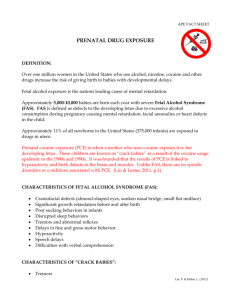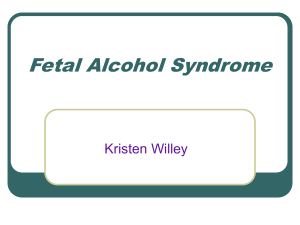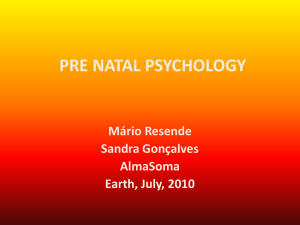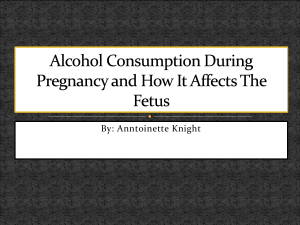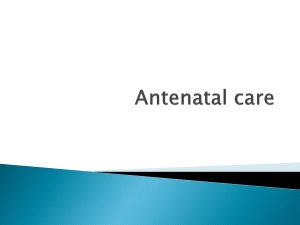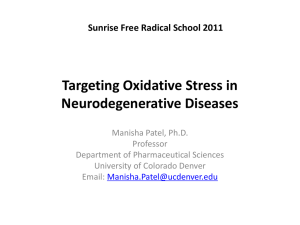Oxidative Stress
advertisement
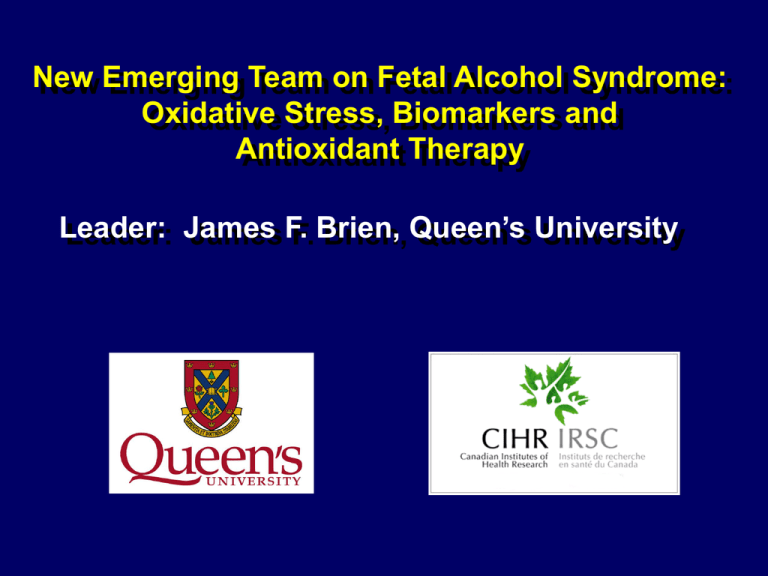
New Emerging Team on Fetal Alcohol Syndrome: Oxidative Stress, Biomarkers and Antioxidant Therapy Leader: James F. Brien, Queen’s University Fetal Alcohol Syndrome • Growth deficiency • Facial characteristics • Brain injury (structural and functional) Alcohol-Related Neurodevelopmental Disorder • Brain injury (structural and functional) Fetal Alcohol Spectrum Disorder • All-inclusive term for the different manifestations of alcohol-induced birth defects (teratogenic effects). Coronal Section of the Brain Critical Periods of Human Development K.L. Moore. The Developing Human, Clinically Oriented Embryology (1988). CIHR NEW EMERGING TEAM ON FAS Antioxidant Therapy C A Oxidative Stress B Biomarkers Members of NET on FAS Alan D. Bocking, obstetrics and maternal-fetal physiology, University of Toronto James F. Brien, basic developmental pharmacology & toxicology, Queen’s University Gideon Koren, pediatrics and clinical pharmacology & toxicology, Hospital for Sick Children, Toronto Stephen G. Matthews, developmental neuro-endocrinology, University of Toronto James N. Reynolds, developmental neuroscience, Queen’s University Joanne Rovet, developmental neuropsychology, Hospital for Sick Children Wendy J. Ungar, health economics and population health, Hospital for Sick Children Research Objectives A. To test the hypothesis that oxidative stress is an important mechanism of the brain injury of FAS. B. To identify and validate reliable biomarkers for fetal alcohol exposure at critical periods of vulnerability during gestation and for the magnitude of fetal alcohol exposure. C. To discover and develop innovative antioxidant treatment strategies for preventing or attenuating the brain injury of FAS. Objective A To determine whether oxidative stress is a mechanism of the brain injury of FAS. Definition of Oxidative Stress Oxygen radicals: highly reactive molecules generated during cell metabolism. Cell degradation Cell of O2 production radicals of O2 radicals Overabundance of O2 radicals/Oxidative Stress Proposed Mechanism of Brain Injury of FAS Maternal Ingestion of Alcohol Fetal Brain Exposure to Alcohol Oxidative Stress / Increased Reactive Oxygen Species H2O2 O2– OH Depletion of Glutathione (a peptide that protects against Oxidative Stress) Damage to Key Cell Macromolecules (DNA, Proteins, Membrane Phospholipids) Fetal Brain Nerve Cell Death Brain Injury of FAS G. Weaver, University of Colorado at Denver Measures of Oxidative Stress 1. Glutathione (GSH): Small intracellular protein (peptide) localized in mitochondria (energy -producing organelles) and other sites within the cell. 2. F2-isoprostanes: Products of chemical reaction: reactive oxygen + membrane species phospholipids lipid peroxidation 8-iso-Prostaglandin F2 3. Neuroimaging of brain: magnetic resonance imaging - structural changes. magnetic resonance spectroscopy - oxidative stress. Investigation of Occurrence of Oxidative Stress 1. Guinea pig study (fetus and neonate) of key brain areas: GSH and 8-iso-PGF2. Following chronic prenatal alcohol exposure: • Decreased mitochondrial GSH content in fetal hippocampus (learning and memory). • No change in 8-iso-PGF2 content in fetal or neonatal hippocampus or other key brain areas. 2. Study of FAS children: neuroimaging of brain for evidence of oxidative stress and relationship to structural changes and cognitive deficits. Objective B To identify biochemical markers in meconium (first stool passed by neonate) as measure of: gestational time and magnitude of fetal alcohol exposure resulting from maternal drinking. Fatty acid ethyl esters (FAEEs) (family of chemical compounds) Products of enzymatic reaction: Fatty acids + Ethanol in in body alcoholic beverages FAEEs Investigation of FAEEs as Biomarkers of Fetal Alcohol Exposure 1. Pregnant guinea pig study: identification of members of FAEEs family that constitute biomarkers of gestational time and magnitude of fetal alcohol exposure. • FAEEs measurable in meconium of term fetus following chronic prenatal alcohol exposure. • No measurable FAEEs in meconium of non-alcoholexposed fetus. • Five different FAEEs identified for chronic prenatal alcohol exposure; ethyl linoleate most common. Investigation of FAEEs as Biomarkers of Fetal Alcohol Exposure 2. Human meconium clinical study: elucidation of prevalence of alcohol consumption by pregnant women in Canada. • 6x Increase in FAEEs in neonatal meconium for heavy prenatal alcohol exposure compared with control. • Seven different FAEEs identified for prenatal alcohol exposure; four FAEEs most common, including ethyl linoleate. Objective C To determine therapeutic efficacy and costeffectiveness of antioxidant therapy for prevention/attenuation of brain injury of FAS. Vitamin C + Vitamin E (pharmacological doses) Investigation of Antioxidant Therapy 1. Guinea pig study: evaluation of efficacy of vitamin C + vitamin E to prevent/attenuate brain injury produced by chronic fetal alcohol exposure. 2. Human studies: • evaluation of therapeutic efficacy and cost-effectiveness of vitamin C + vitamin E in preventing/attenuating brain injury of FAS. • investigation of determinants of recruitment and retention of pregnant alcohol-using women in preventative treatment. CIHR NEW EMERGING TEAM ON FAS Antioxidant Therapy C D Training 2 PDF 3 PhD 3 MSc A B Oxidative Stress Biomarkers
